Artist Statement
In creating Posh Pooch, our first thoughts were to have a fellowship-focused game, as the assignment dictated, with the key mechanic being a judging factor. We hoped that through players submitting their answers to be judged, there would be lively discussion, arguments, and ‘anti-fellowship.’ On the first day of ideation, one of our team members also came up with the theme of a dog show, in which the main game goal was to dress up your dog in various outfits. The reasoning behind this theme was that the games we played for the critical plays were saturated with themes of war, fighting, and/or violence. We wanted to create a light-hearted game that could be enjoyed in a similar manner featuring anti-fellowship, but with a sillier, less serious backdrop. Additionally, in the process of development, we stumbled upon a storytelling dynamic that worked very well in adding a creative aesthetic to the game. We hope that in playing this game, our players will feel fellowship to other players as well as their dogs, creativity, and a light-hearted spirit.
Concept Map:
Posh Pooch Concept Sketching_P1_Ellie Vela, Emily Macias, Ritkia Kacholia, Jasmine Padilla
Initial Decisions About Formal Elements:
To evoke the experience of competing in a dog show, we centered our initial concept around a few key elements: (1) prompts that give players a goal for designing their dog, (2) cards players use to accessorize their dogs, and (3) an objective that would get players to argue in favor of their dog. The rest of the game was filled-in to support these elements. As judging is a common mechanic that gets people to argue, we decided to incorporate it into our first prototype. We then brainstormed clothing items and superlatives that we sorted into a deck of “accessory cards” and a deck of “prompt cards”. At the start of the game, a judge was selected. Then, play proceeded in rounds, started by revealing a prompt card. Players took turns each drawing a card from the accessory deck. At any point before judging, players could try to negotiate trades for accessories with other players. The round continued until everyone agreed they were ready to present their dog. Then, players each pitched their dog and the judge chose a winner. We played a few rounds to test this version of the game.
Playtest #1:
To most effectively explore our design space, we tweaked our prototype’s mechanics as we played several successive games. Firstly, we decided to switch from judge to voting. Judges did not participate in drawing and trading, so switching to voting allowed all players to be actively involved at all stages of the game. In this voting based-system we counted to 3 and simultaneously pointed to the player that we wanted to win. We also tried mixing the prompt card into the accessory deck so that it was only revealed once it was pulled by a player. Players could trade cards only up until the prompt card was pulled and revealed, and we hoped adding a time constraint would incentivize players to trade earlier and more often. Another major change was testing out a sabotaging mechanic, which we added in order to get players to interact with one another. We made this change because one of our biggest goals for Posh Pooch was that players would be constantly interacting and talking to each other in a way that fostered a competitive spirit among its players, similar to how players interacted in games like Old Maid and Mafia. Lastly, a major finding from our first playtest was the discovery of an unintentional dynamic for our game which was that when trying to pitch our dogs, we used storytelling as our main tool, prompting us to intentionally center this dynamic of our game in our rulebook. During our playtest we used the clothing items that we pulled from the deck to come up with stories about dogs with capes and underwear making amazing chefs, dogs with spring shoes having superhero arcs, and rich dogs stealing cars to drive to McDonalds in an attempt to convince each other that our dogs were worthy of winning rather than just sticking to a logic-based description of why our clothing items were the best fit for the situation described on the prompt cards. This unintentional dynamic allowed for humor in the game as we laughed at each other’s creative stories and commented on them, increasing the fellowship aesthetic of our game.
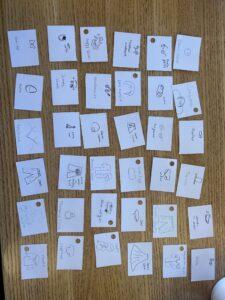
Playtest #2:
The second playtest of Posh Pooch was conducted in class with 4 people. Our questions going into the playest revolved around whether the prompts and accessory cards were funny enough, whether the storytelling aspect still shined through with a group of strangers, and whether players actually felt a natural inclination to trade or sabotage. During our playtest we found that some of the humor in our prompts and in our accessories fell flat. Our players were able to come up with funnier storylines and have more fun building their stories when accessory cards were very specific such as “pants with mud on the butt” in contrast to something basic like “a t-shirt.” During this playtest it was also clear that our prompts needed to be funnier and more unhinged as players did not express as many positive reactions when they were revealed as we hoped. Players also expressed that it was jarring for the prompt card to be mixed into the deck and that they were unmotivated to trade if they did not know what the prompt card was going to be. Based on this playtest we decided to reveal the prompt card at the very beginning of a round and to revise our prompt cards and accessory cards to be much more specific and silly (in an attempt to make the game funnier), and to encourage more sabotage and trading. We really wanted Posh Pooch to be a game that encouraged people to compete with one another, to banter, and laugh throughout the process, so we focused on trying to make changes that would make the game more “unhinged” and that would encourage much more interaction between all of the players in a way that contributed to our playful anti-fellowship goal.
Playtest #3:
In order to encourage more interaction and banter between players, for our third playtest, we introduced the idea of group cards which were shuffled into the card deck. The group cards each contained an action that prompted players to interact such as “everyone must trade one card” or “sabotage another player.” This version of the game was played by 3 people in class. Our questions going into the playtest was: do group cards encourage interaction that adds a level of fun to the game? Were we successful in making the prompts and accessories funnier? Overall, the results of this playtest were very positive! The group cards slowed down the pace of the game because players interacted with each other more often and they encouraged lying which reduced trust among players and contributed to a sense of anti-fellowship much earlier in the game. Every round was much more interesting because players were doing more than just picking up a card, they were trading, lying to each other, and sabotaging each other’s dogs. However, we did get 3 main points of improvement for our game. Firstly, players suggested the possibility of increasing what happens at each turn even more by having players gradually build up their dogs across multiple rounds and pitching it several times instead of only one time at the end of one round. They also suggested having an increased number of “bad” cards such as the muddy or ripped clothing that already existed in order to make sabotaging more interesting. Lastly, one problem that resulted in the game was that the first person to pitch their dog got sabotaged the most, leaving us to decide how to more evenly distribute sabotages in the game.
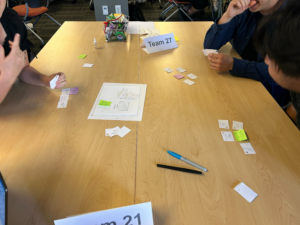

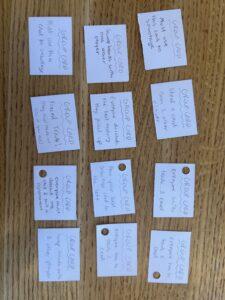
Playtest #4:
For our final playtest, we wanted to solidify a lot of the mechanics that had been switched around in the previous playtests. We decided that players would draw cards 8 times, going around in a sequential order around the table. This mechanic change had a poor outcome, as the drawing cards phase of the game felt really drawn-out for the players. The feedback we received for this round told us that we needed to reduce the time spent drawing cards and increase time telling stories and judging, as “that was where the fun was.” Additionally, they said that the group cards did not provide as much fun as they should have. The development team decided that the group cards posed an issue when drawn subsequently and when drawn into the initial hand at the beginning of the game. To fix this issue, we decided to separate accessory and group cards in the next playtest. We also determined that group cards that only affected one player were more frustrating to the player and did not add to fun or fellowship. Therefore, we edited the group cards in a later playtest. Another introduction, we added dog character cards that were laminated and were able to be drawn on with a whiteboard marker. The dog character cards were a huge success, with every player naming their dog silly names such as “Dogtor Bones,” “Chicken Little,” and “Little Miss Back From Cabo” that complimented their stories. These character cards were something we were very proud of because they contributed to the sensation aesthetic of our game as throughout our playtests, players expressed a sense of attachment and pride in the dogs that they were able to adopt and even name which was a positive outcome since we hoped people would enjoy physically interacting with and seeing the cute dog cartoon profiles that accompanied Posh Pooch’s card deck.
Playtest #5:
For our fifth playtest, we decided to play the game as a group in order to address issues that we saw during our final in-class playtest which related to the game taking too long to get to the storytelling phase because of the volume of group cards that were pulled and the amount of times all players pulled cards. We also wanted to try out a new idea that we had gotten by our players throughout a couple of our playtests which involved building up your dog little by little across multiple rounds instead of getting completely fresh accessories. During our playtest we separated out group cards from the accessories deck and only pulled a single group card for each round. We found that building up our dogs gradually ended up being a much larger challenge when trying to storytell and ended up restricting our creativity. Narrations were less naturally silly and we had to place more effort into making our dogs’ outfits make sense (in a negative way). So, we decided to stick with choosing a brand new outfit for our dogs every round! For this playtest, one of our main goals was to test many ways that players might interact with group cards. Apart from trying a format where players pulled only a single group card at the end of one round, we also tried giving the players an option to either pull an accessory card from the deck or a group card when it was their turn to add a card to their personal hand. We found that there was not much motivation to pull a group card instead of an accessory card and discarded this idea. Instead, we decided to maintain our current group card format (where they were mixed in with the deck), but remove group cards that previous playtesters expressed negative emotions about and reduce the amount of times each player had to pull a card from the deck in order to address the concern that it took too long to reach the storytelling portion of our game! This meant that users started off with 4 cards in their hand and drew only one card each (i.e. only one round of drawing versus 8 like in our last version). We also decided to switch back to the judging format of the game instead of continuing with the group voting format because we felt it incentivized stronger, more passionate, and tailored pitches!

Playtest #6:
In our final playtest, we wanted to confirm that our largest changes made sense. We decided that used accessory cards would not carry over to subsequent rounds, due to the increased challenge and reduced creativity. To keep the rounds cohesive, we decided that cards remaining in a player’s hand would be kept to be used in following rounds. We also added the groupcards back into the accessory card pile…
The one glaring issue with our final playtest was that players very quickly ran out of cards. One player played their whole hand in the first round and was left with only 0-2 card hands the whole rest of the game. To fix this issue, we decided to have players draw back up to 4-card-hands at the beginning of each round. However, this allowed for the possibility of drawing multiple group cards before the start of each round. Instead, we chose to re-separate the group cards from the accessory cards and have players reveal one group card each round right before judging.
Despite this, the aesthetic of fellowship was really tested and successful in this playtest due to the players being already close to one another. It was very evident that in this game, the pre-existing knowledge of players’ backgrounds and preferences proved an advantage in the judgment of the dog stories. This suggests that Posh Pooch may be better suited for a group of players that are already familiar with one another. Having fewer players also allowed for more banter between players. Because there was less pressure to make time for other players to present their dogs, players had time to interject during each others’ presentations. Allowing time for arguing back-and-forth created the anti-fellowship aesthetic we had been looking for.
Final Prototype:
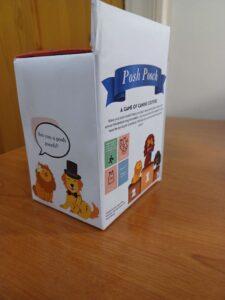
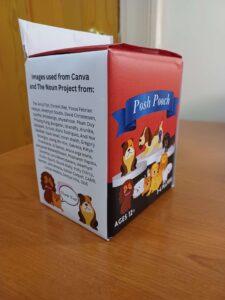
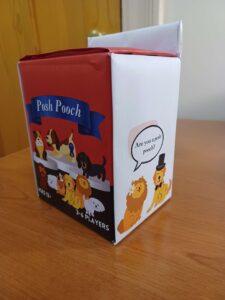
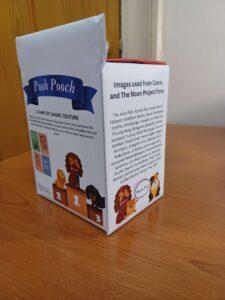
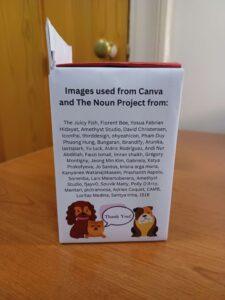



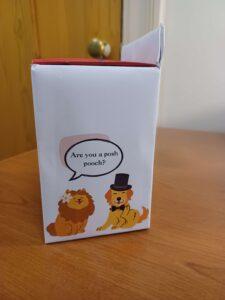
Find our Print-N-Play Here:Posh Pooch Print-and-Play
Video of Final Playtest



